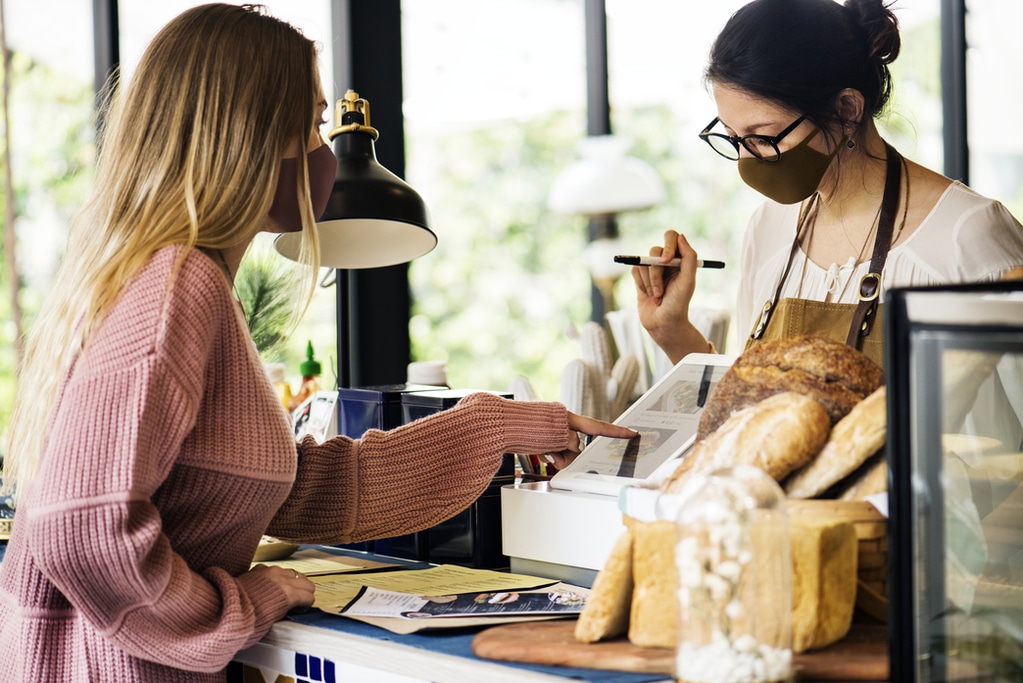
In a society that can barely handle regular physical boundaries of one foot between people, 6 feet seems nearly impossible. Even in the past two months, the simple act of a handshake is no longer occurring in most business settings, including interviews. Regular customers can no longer shake your hand, nor can any potential hugging occur amongst friends. Now we are resorting to virtual handshakes, a head nod, or a respectful bowing. It’s a huge change for most people!
Know What is Going On
Watching the news 24/7 isn’t expected; however, it will be important for you to keep current with the newest developments during this pandemic. Employees and customers will look towards you as a leader during this time and need that reassurance, particularly with understanding local restrictions. This may be a good time to coordinate with other business owners via phone conferencing for a regular ‘state of the neighborhood’ discussion.
Basic Tips and Safety Concepts
The ways to keep customers safe through COVID-19 is starting with establishing boundaries set forth by government and to use your imagination. Some business owners are using tape or spray paint to mark lines just over 6 feet apart for cueing. Others verbally remind customers to remember to wash their hands before they eat, and to properly clean the area after they finish eating. The second part of keeping customers safe is to crack-down on staff who are ill and sending them home. Please see our article ‘Surviving COVID-19: Illness or Coronavirus… Ensuring Staff Stay Home When Sick’ for additional information.
The third yet critical item in keeping customers safe is to follow the additional cleaning guidelines by health districts and inspectors. While it’s really a no-brainer for the food service industry, it’s quite interesting that other sectors find themselves struggling in this area. It’s all about having a proactive measure to hinder the possibility of the virus spreading through surfaces regularly touched by different people. Many restaurants also have staff wearing gloves, which further hinders the potential spread and protects employees and customers alike.
Also consider how your business will interact with customers who appear ill. While it’s easy to think you’ll simply throw them out, remember that they may have already had a test that was negative but have allergies or a simple head cold. A compassionate way to interact with them would be to hand them extra napkins to sneeze or cough into, have a hand sanitizer station for customers to use as they enter your establishment, and discreetly clean and sanitize the area in proximity to where they were located.
Finally, if you offer delivery, be sure to offer a no-contact delivery option. This allows anyone to pay for the order and for it to be left on a doorstep or porch without invading the 6-foot boundary. Unknowingly, you may be providing a great service to those with compromised immune systems, those in higher risk age-groups, or those ill with COVID-19.
Reports of a Positive Diagnosis
With every-growing numbers of ill people diagnosed with COVID-19, do you have a plan of action if an employee or customer reports they are positive? Do not wait until it happens; plan proactively so you have the ability to remain calm and present the facts (without disclosing a name). There is a lot of information available, and as an employer, you will need to discuss the issue with employees. Just be sure to take it one step at a time as hasty decisions or announcements will only spread fear. It is suggested to speak with an attorney or legal professional regarding your obligations as an employer, and what steps are required versus what you may want to do additionally.
Some things to consider include:
- knowing where and when the COVID-19 positive person was in your business and which days they may have been contagious
- who they came across (not necessarily physical contact)
- what food they may have been near, prepped or handled
- depending on the timing of when the person was in your business may conclusively indicate any/all staff need to self-quarantine, food may need to be destroyed and replaced, and a full deep clean of the restaurant is needed
- Regardless of considerations, your local health district may have additional criteria or requirements.
Mental Health and Social Distancing
One particular consideration often forgotten about safety is mental wellness. If you are constantly at least 6 feet away from others, it will affect mental health. After all, humans are sentient beings. The power of proximity and touch has long been studied including its’ social affect. According to some sociologists, once the restrictions are lifted, we may see a semi-permanent shift of physical interaction depending on the individual. All reactions are normal, as we fall into a natural rhythm of social distancing, it may lock in tight for long afterward. For others, they may crave physical touch and shake hands more often or pat others on the back or forearm.
This is important to safety because a decline in mental health can lead to depression, aggression, and even potential suicide. During this time, know the signs of depression and where people in your community can seek help. It’s not only okay to not be okay, it is absolutely okay to ask for help. It is also okay to ask if someone is doing okay.
Many who prefer not to shake hands, or those with less need of social tendencies are soaking up every moment of distancing they can get; however, others will find it a struggle, and have anxiety, fear, or added stress from the 6 foot boundary. Be patient and kind yet set boundaries. Remind others of the boundary by setting a good example for others. In time, we’ll all get through this, together.

